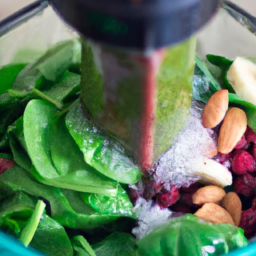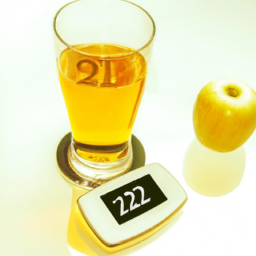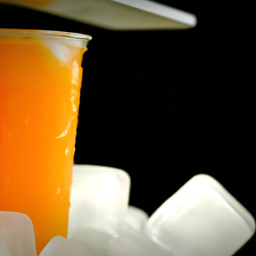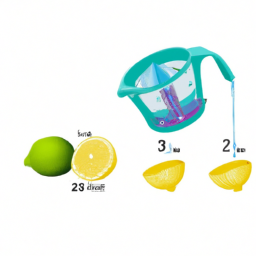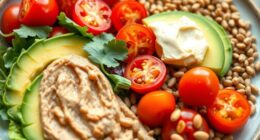Tired of waking up feeling like a zombie? Struggling to get through the day without multiple coffee breaks? Look no further – Jitter Juice is here to save the day! This amazing brew will not only wake you up from your sleepiness, but will also give you the energy you need to conquer the day ahead.
Jitter Juice is a combination of coffee and energy drink that will kick your taste buds into overdrive. It’s like the superhero of beverages – it saves the day by giving you the boost you need. And the best part? You can customize it to fit your taste preferences.
Whether you like it sweet, creamy, or bold, Jitter Juice can be tailored to your liking. So, let’s get started on making this energizing drink that will have you feeling like a superhero in no time.
Key Takeaways
- Jitter Juice is a combination of coffee and energy drink that provides an energy boost.
- Freshly brewed coffee is necessary for the recipe and different types of coffee beans and brewing methods can be experimented with.
- Red Bull, Monster, and Rockstar are popular energy drink options to consider, but caffeine levels should be compared when choosing an energy drink.
- Garnishes like whipped cream, chocolate shavings, and fresh berries can be added for presentation and flavor, and alternative options like green tea or herbs like ginseng can be used for a healthier option.
Gather Your Ingredients
You’ll need to gather all of your ingredients before you can start making this delicious jitter juice. The basic ingredients include coffee, milk, ice, and sugar. However, you can also experiment with different flavors and ingredient substitutions to create your own unique variation of jitter juice.
For instance, you can use almond milk or coconut milk instead of regular milk to make it vegan-friendly. You can also add a touch of vanilla extract or cinnamon powder to enhance the flavor profile.
To make the perfect jitter juice, you need to use freshly brewed coffee. You can use any type of coffee that you like, whether it’s dark roast or light roast. The coffee should be brewed strong to give the jitter juice a rich and bold flavor.
Once you have brewed your coffee, let it cool down to room temperature. Then, you can add ice to a blender along with the coffee, milk, and sugar. Blend until smooth and creamy.
Now that you have gathered all of your ingredients, it’s time to prepare your coffee and start making the perfect jitter juice.
Prepare Your Coffee
First, brew a strong cup of coffee using your preferred method. Whether you prefer a French press, drip coffee maker, or espresso machine, there are a few tips to keep in mind to ensure the perfect cup.
Start by using high-quality coffee beans and grind them right before brewing for maximum freshness. Make sure to use the correct ratio of coffee to water, typically one to two tablespoons of coffee per six ounces of water. If you want to enhance the flavor, try adding a pinch of salt or cinnamon to the grounds before brewing.
There are also different types of coffee beans to try, each with their own unique flavor profile. For a bold and robust flavor, try a dark roast like French or Italian roast. For a more fruity and acidic taste, go for a light or medium roast like Ethiopian or Costa Rican. Experiment with different types of beans and brewing methods to find your perfect cup of coffee.
Now that your coffee is ready, it’s time to choose your energy drink.
Choose Your Energy Drink
Now that you’ve got your perfect cup of coffee, it’s time to pick out the energy drink that will give you the boost you need to power through your day.
When choosing an energy drink, it’s important to compare caffeine levels to ensure you’re getting the amount of energy you desire. Some popular energy drinks include Red Bull, Monster, and Rockstar.
Once you’ve selected your energy drink, it’s time to consider the flavor. The best flavors to choose depend on your personal preferences, but some popular options include original, sugar-free, and fruit flavors. It’s also important to note that some energy drinks can be quite sweet, so consider mixing it with a less sweet coffee blend.
Finally, when serving your jitter juice, consider adding ice for a refreshing twist.
Now that you’ve chosen your energy drink and coffee, it’s time to mix them together and enjoy your homemade jitter juice.
Mix Together Coffee and Energy Drink
As you blend the rich and bold coffee with the electrifying energy drink, it’s like combining the power of a thunderstorm with the warmth of a cozy fire. This step is crucial in creating the perfect Jitter Juice, as it sets the foundation for the ultimate energy boost. To ensure the best results, use freshly brewed coffee and your preferred energy drink, whether it be Red Bull, Monster, or any other brand of your choice.
To help you choose the right combination, here’s a table of some popular coffee and energy drink pairings that you can try for your Jitter Juice:
| Coffee | Energy Drink | Flavor Profile |
|---|---|---|
| Espresso | Red Bull | Bold and intense, with a hint of sweetness |
| Cold brew | Monster | Smooth and refreshing, with a slight bitterness |
| French press | Rockstar | Rich and full-bodied, with a sweet finish |
| Americano | NOS | Strong and sharp, with a tangy aftertaste |
| Mocha | Full Throttle | Creamy and chocolatey, with a kick of caffeine |
Before mixing your ingredients together, it’s important to note the Benefits and Risks of consuming energy drinks. While they can provide a quick burst of energy, they can also lead to negative side effects such as increased heart rate, anxiety, and insomnia. Alternative Options such as natural energy sources like green tea or herbs like ginseng can be used if you prefer a healthier option. Once you’ve chosen your ingredients, mix them together and enjoy your Jitter Juice as is, or add ice (optional) for a refreshing twist.
Add Ice (Optional)
You can enhance the refreshing twist of your Jitter Juice by adding ice to the blended coffee and energy drink mixture. Ice not only cools down the drink, but it also adds a satisfying crunch to each sip. Here are some ice options to consider:
-
Regular ice cubes: This is the classic way to chill your drink. Simply add a few ice cubes to the blender, and blend until they’re crushed and mixed with the other ingredients.
-
Coffee ice cubes: Make your Jitter Juice even more coffee-flavored by freezing leftover coffee in an ice cube tray. Use these coffee ice cubes instead of regular ice cubes for a stronger coffee taste.
-
Coconut water ice cubes: If you want to add a tropical twist to your Jitter Juice, freeze coconut water in an ice cube tray. These coconut water ice cubes will add a subtle sweetness and a unique flavor to your drink.
If you don’t have any ice on hand, here are some alternatives to consider. You can chill your coffee and energy drink in the fridge before blending, or add a splash of cold milk or cream to the mixture.
Now that we’ve added ice, let’s move on to the next step: blending (optional).
Blend (Optional)
Congratulations, you’ve reached the optional step of blending your Jitter Juice into a smooth and creamy beverage that’ll take your caffeine game to the next level.
Blending benefits go beyond just texture and consistency, as it also allows you to incorporate alternative methods of enhancing the flavor profile. For example, adding a scoop of vanilla ice cream or a drizzle of chocolate syrup can create a delightful mocha-like flavor that’ll leave you wanting more.
To blend your Jitter Juice, simply pour the mixture into a blender and blend on high speed for about 30 seconds or until smooth. If you don’t have a blender, you can also use a hand-held immersion blender or a milk frother to achieve a similar result.
Once blended, pour your Jitter Juice into a glass and enjoy as is or move on to the next optional step of garnishing your beverage.
Transitioning into the next section, adding a garnish is another optional step that can take your Jitter Juice experience to the next level.
Garnish (Optional)
Elevate the presentation and flavor of your caffeine fix with an optional garnish for your blended beverage.
Some garnish ideas to consider are whipped cream, chocolate shavings, cinnamon sugar, or a sprinkle of nutmeg. These toppings not only add a pop of color to your drink but also complement the flavor profile of the Jitter Juice.
For instance, whipped cream adds a creamy texture that balances the strong coffee taste, while chocolate shavings offer a bittersweet taste that complements the rich coffee flavor. When it comes to flavor options, you can experiment with a variety of garnishes to achieve the desired taste.
For a fruity twist, try adding fresh berries like strawberries or raspberries on top. Or, if you prefer a nutty taste, sprinkle chopped hazelnuts or almonds over the whipped cream. The possibilities are endless, and you can mix and match garnishes to find the perfect combination that suits your taste buds.
Serve and enjoy!
Serve and Enjoy!
Now that we’ve made our delicious jitter juice, it’s important to remember to drink responsibly.
While this drink can be a fun and energizing treat, it’s crucial to limit your intake and not overdo it.
As someone who loves to enjoy a good beverage, I always make sure to keep track of how much I’m consuming and pace myself accordingly.
So, sit back, sip slowly, and savor the flavors of your homemade jitter juice!
Drink Responsibly
Before indulging in the energizing effects of jitter juice, it’s important to remember to drink responsibly. Although jitter juice is a great alternative to energy drinks, excessive consumption can lead to negative effects such as increased heart rate, jitteriness, and difficulty sleeping. To avoid these effects, it’s recommended to limit your intake to one or two servings per day.
To help you keep track of your caffeine intake, here’s a table comparing the caffeine content of jitter juice with other popular beverages:
| Beverage | Caffeine Content |
|---|---|
| Jitter Juice | 200 mg/serving |
| Coffee | 95 mg/cup |
| Red Bull | 80 mg/can |
| Coca-Cola | 34 mg/can |
As you can see, jitter juice has a higher caffeine content than most beverages, so it’s important to consume it in moderation. To further reduce your caffeine intake, you can also try alternatives to energy drinks such as herbal tea or fruit smoothies. By drinking responsibly, you can enjoy the energizing effects of jitter juice without experiencing any negative side effects.
Limit Your Intake
To avoid negative effects, it’s important to limit how much caffeine you consume. For example, my friend Sarah used to drink multiple cups of coffee every day, but after experiencing heart palpitations and difficulty sleeping, she decided to switch to herbal tea and limit herself to one cup of coffee per day.
Health risks associated with excessive caffeine intake include increased anxiety, high blood pressure, and disrupted sleep patterns. Moderation is key when it comes to consuming caffeine, so it’s important to be mindful of how much you’re consuming and to limit your intake accordingly.
If you’re making Jitter Juice, be sure to measure out the amount of coffee you’re using and don’t go overboard with the caffeine. Too much caffeine can make the drink too bitter and overwhelming.
Additionally, Jitter Juice is best enjoyed in moderation as it is a stimulating and energizing drink. It’s important to be aware of your own caffeine tolerance and to adjust the recipe accordingly.
In the next section, I’ll show you how to customize your recipe to fit your preferences and needs.
Customize Your Recipe
Customize your recipe by adding your own personal touch. Experiment with different combinations of fruits and spices to give your jitter juice a unique flavor that reflects your individual taste preferences.
Start by selecting a base fruit, such as strawberries, blueberries, or raspberries. Then, add complementary flavors like ginger, mint, or cinnamon. You can also adjust the caffeine levels by adding more or less coffee or tea depending on your desired energy boost.
If you prefer a sweeter taste, add honey or agave syrup to your recipe. For a bit of spice, try adding a pinch of cayenne pepper or a dash of nutmeg. Don’t be afraid to get creative and mix and match different flavor combinations until you find the perfect blend that suits your taste buds.
Once you’ve perfected your recipe, serve your jitter juice over ice and garnish with fresh fruit or herbs for a refreshing and energizing drink that’s perfect for any time of day.
Frequently Asked Questions
What is the nutritional value of jitter juice?
Jitter juice is a nutrient-rich beverage that provides numerous health benefits. It is a great addition to any diet and can be incorporated in various ways. It has a unique flavor profile and can be served as a refreshing morning drink or a pre-workout boost.
Can I use decaf coffee for this recipe?
Yes, you can definitely use decaf coffee as an alternative for Jitter Juice if you prefer caffeine-free options. It won’t affect the flavor profile and you can still enjoy the same delicious taste with creative ingredient combinations.
How long can I store jitter juice in the refrigerator?
Jitter juice can last up to five days in the refrigerator, but it’s best when consumed within two to three days. Its shelf life expectancy may be extended by freezing it in ice cube trays for future use.
Are there any potential side effects of consuming jitter juice?
I’ve found that consuming Jitter juice can lead to negative effects on my sleep patterns and can be dangerous for those with low caffeine tolerance. It’s important to be aware of the potential risks before indulging in this flavorful concoction.
Can I substitute a different type of energy drink in this recipe?
Yes, there are alternative substitutes for energy drinks in this recipe. However, the taste comparison may differ. I recommend using a similar caffeine content substitute for optimal results. Experiment with different products to find your preferred taste.
Conclusion
Well, that’s it folks! You’ve learned how to make your very own Jitter Juice. It’s a simple yet effective way to give yourself that much-needed energy boost throughout the day.
This drink is perfect for those early mornings when you just can’t seem to shake off the grogginess. It’s also great for those late nights when you need to stay up and finish that project.
Mixing coffee and energy drink may sound like an odd combination, but trust me, it works like magic. It’s like a symphony of flavors that wakes up your taste buds and gets you buzzing. And just like a symphony, you can customize this drink to your liking.
Add more coffee if you want it stronger or more energy drink if you need a bigger jolt. The possibilities are endless.
So go ahead and give this recipe a try. It’s quick, easy, and oh-so-delicious. And who knows, it might just become your new favorite drink. As they say, it’s like a shot of lightning to the system.
So sit back, relax, and enjoy the ride!
Ilana has been a vegan for over 10 years. She originally made the switch for health reasons, but soon found herself becoming more and more passionate about the ethical and environmental implications of a vegan lifestyle. Ilana is the author of The Graceful Kitchen, a blog all about veganism. She loves to cook up delicious and nutritious vegan meals, and share her recipes with others who are interested in leading a cruelty-free life. Ilana is also a strong advocate for using whole foods as the foundation of a healthy diet, and believes that going vegan is one of the best ways to achieve this.
